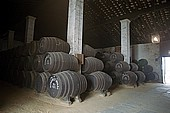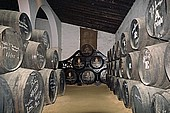| enter keyword to search: |
|
Images db
|
|
|
Articles db
|
|
|
|
|
| Photo Gallery Spanish
Agriculture |
|
| Jerez de la Frontera and the Sherry bodegas |
|
Called "Xerish" or "Xeres" by the Arab, called 'Sherish' by the English, always upholding traditions, using a slight variation of the Arab name, centre of sherry and brandy production for thousands of years,
Jerez de la Frontèra is the inland apex of the Sherry triangle, a small region of low undulating chalk hills facing the Atlantic Ocean, where you will find the top names bodegas in the sherry world.
Few wines from ancient times are still being marketed today, the Phoenicians brought vines to the Jerez region in 1100 BC. During the Arab domination of Spain, the consumption of Sherry was kept up without problems, despite the Koranic prohibition, when the Alcázar (fortress) was captured by the troops of King Alphonse X (the wise) in 1264 the Arab settlement had 21 wine cellars. In the 12th Century the Jerezians started to ship their wines to England. In 1587 Sir Francis Drake, setting on fire the whole of the Spanish fleet in Cadiz, managed to bring home some 300,000 gallons of sherry, contributing to establishing a taste for the wine in Britain. In the late 18th and early 19th centuries, a large number of English, Irish and Scottish merchants arrived and settled in the area.
Andalucia, Jerez de la Frontera
|
 |
Here the impact of climate is evident, every fino or manzanilla of the region is made from the same Palomino Fino grape, reared on the same fine white ‘albariza’ chalky soil, harvested and treated the same way in the winery, yet the wines vary considerable depending in which apex of the triangle they are maturated. Jerez de la Frontèra being the furthest inland place, produces the boldest wines.
One famous bodega is the Gonzalez Byass, home of Tio Pepe. Visiting it you will discover the classic Jerezana bodega design:
la concha (the seashell) a circular bodega attributed to Eiffel; "la cuadrada", in the perfect square shape, is the prototype of the standard Jerezana cathedral;
“los Apostoles” called because it houses an immense barrel with 33 times the capacity of a normal barrel and called “El Cristo”, accompanied by a further 12 large barrels, each bearing the name of one apostle, but with the exception of the Judas Iscariot barrel which can be found in the vinegar bodega;
“los Reyes” (the Kings) another classic Jerezana bodega dedicated to the Spanish Royal Family that houses the finest wine treasures. The 'cathedrals' look almost the same from bodega to bodega: a very high cellar, black butts stacked on hard earth floors sprinkled with water to maintain humidity lined up in rows three or four high. The cellars are built with a North-West South-East orientation that provides for the minimum hours of direct sun and the maximum humidity, facing the sea so that the wine can benefit from the morning sea breeze and from the westerly winds.
Ageing wines takes place through the laborious, precise process known as the "criaderas y solera" system. Until the second third of the 19th Century, wines were aged through the system of 'añadas' (crop years or vintages), in which wine from each year's harvest was kept separately. With the butts lined up in rows the oldest wine was kept in the bottom level called the 'solera', from its proximity to the floor ('suelo', in Spanish) and various series of preliminary aging casks called 'criaderas', or nurseries, on the upper levels. To provide wines with more homogenous and uniform flavor this new system is nowadays adopted. After the first fermentation, wines that will become finos will be fortified by adding wine spirits up to 15º, the rest becoming oloroso is fortified up to 18º, all will lie in American oak casks for a year. After the traditional Jerez process of "Solera y Criaderas" begins, during five years the wine from the top levels criadera scales down to the bottom solera level, mixing the various añadas wines. The wine for bottling is only drawn from the lower tier, the solera.
 |
Andalusia, Jerez de la Fontera
|
The town has a baroque Cathedral with some added Gothic and Neoclassical elements and the 11th century
Alcázar with the rests of an Arab defence wall and a superb octagonal tower (Torre Octogonal).
| |
|
|
 |
|
|



